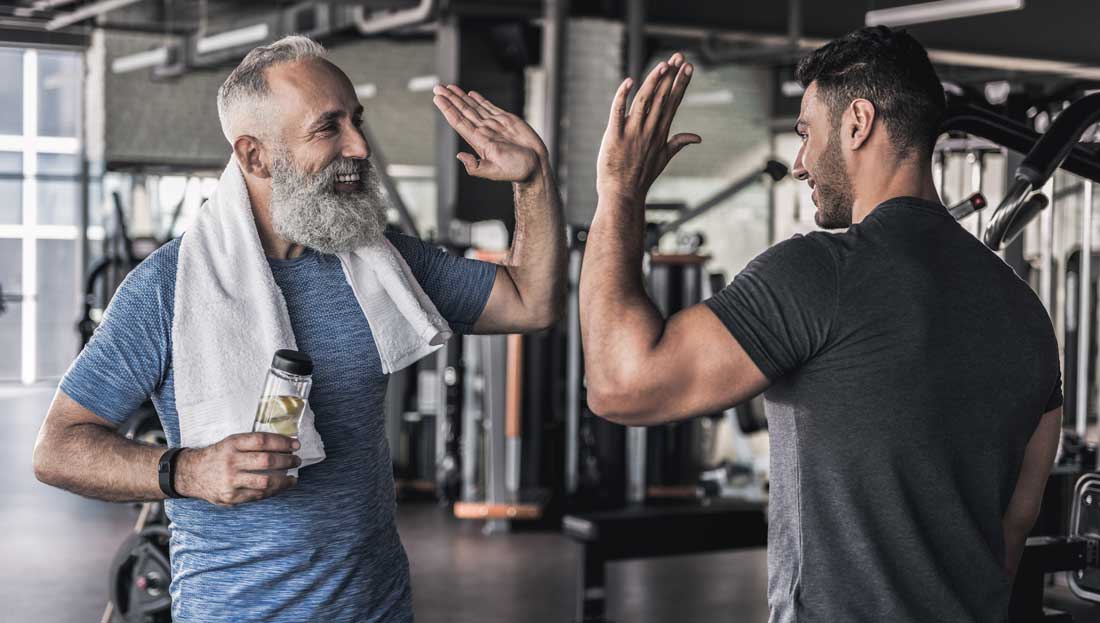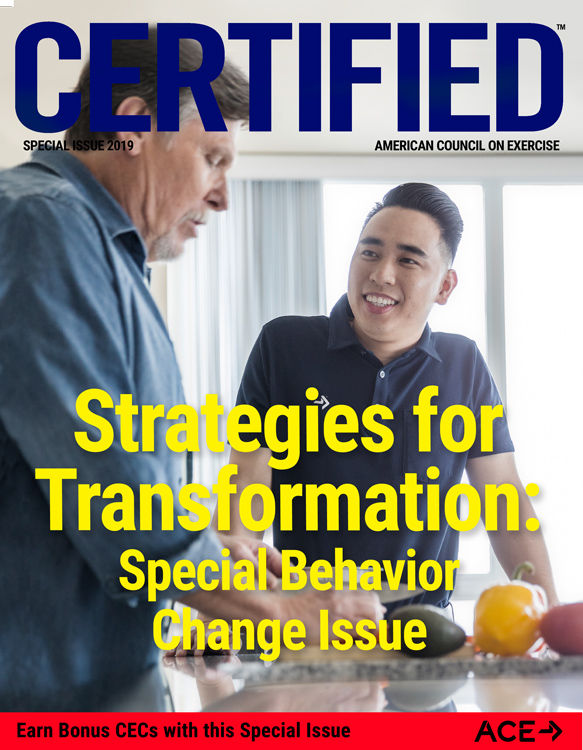
Self-efficacy refers to an individual’s belief in his or her ability to complete a task successfully or meet future challenges. Helping clients to improve self-efficacy is one way to increase confidence in their current abilities as well as confidence in meeting future goals.
Albert Bandura’s renowned self-efficacy theory (Bandura, 1977) has been studied for decades and is included as a construct in other health behavior change theories, including the Social Cognitive Theory and the Health Belief Model.
While self-efficacy is not the only predictor of client success, it’s worth focusing on to help improve client confidence and motivation (Williams and Rhodes, 2016). This may be particularly important for those who have physical limitations or barriers to exercise. For example, a 2018 study examined the relationship between having a physical barrier to exercise (arthritis) and self-efficacy and found that “when facing the greatest barrier challenge, individuals highest in self-regulatory efficacy still view exercise as possible” (Sessford et al., 2018).
Improved self-efficacy also appears to be linked to better physical function and increased activity levels. For example, a 2018 randomized clinical trial studying the effect of intensive diet and exercise on self-efficacy in overweight and obese adults with knee osteoarthritis found that participants with higher self-efficacy reported significantly better physical function and less knee pain at baseline, walked farther and were more physically active (Mihalko et al., 2018).
In summary, even among people facing great physical challenges, those with higher self-efficacy had greater results, greater confidence and were better able to overcome challenges.
A Framework for Enhancing Self-efficacy
Albert Bandura’s self-efficacy theory is based on the following framework, which can be used by health coaches and exercise professionals to help clients improve self-efficacy.
Performance Accomplishments
Learn by doing. Having your clients consistently practice a new skill is an ideal way to help them gain mastery. Failure (or perceived failure) undermines self-efficacy, but it’s important to note that “quick wins” are only helpful at the beginning of a habit change. If a client expects easy success week after week, he or she is not fostering resilience and will be disappointed when workouts get challenging.
Helping clients get outside of their comfort zones with the “safety” of the trainer or coach present is crucial in building confidence. You can also help your clients learn to anticipate times that can make it challenging to keep up with their plans (such as vacations, holidays and busy work seasons), but in those moments they can rely on you to help get them back on track.
Applied Coaching
Start with body-weight exercises before adding external resistance or load (e.g., body-weight squats, jumping jacks, arm circles, cat-cow). And help your clients anticipate challenges by creating circuit workouts that they can do when they are out of town or don’t have time to hit the gym when life gets busy. Be sure to provide your clients with a printed or electronic copy of the workout.
Vicarious Learning
Modeling is crucial. Let your clients watch you complete the task. Tell them about how other clients have completed similar goals or let them meet other clients in similar situations. (Note: This is only helpful if the client perceives him or herself as being very similar to the other person).
Applied Coaching
Group coaching or small-group workouts can be an ideal environment for clients to gain confidence through vicarious learning.
Social Persuasion
“Cheerleading” or praising can be helpful for a short time and can play a role in training. However, using motivational interviewing techniques (see sidebar, below) can help clients find intrinsic motivation and talk themselves into completing a task or meeting a goal. By asking open-ended questions about the client’s goals, perceived barriers and strengths, you can help move the client toward confidence. Create situations that foster success, especially after a client has pushed hard.
Applied Coaching
Get to know what motivates your client. Is it playing with his grandkids? Does she want to feel confident for her wedding or other big event? When you have an understanding of your client’s long-term motivation and goals you can relate the small day-to-day tasks to the outcomes he or she is training for. Ask about what your client enjoys and tailor workouts to make them more fun and engaging. For example, if a client likes gardening discuss strengthening legs, back and core for bending and squatting in the garden. If a client likes dance or cardio, incorporate circuit workouts, and if he or she generally likes low-impact yoga or walking, use these activities as a warm-up or cool-down for the primary workout.
Affective Arousal
Help your clients to interpret their results and actions. If a client is having a hard day and feeling lousy or self-conscious, remind him or her that it’s normal to have a hard workout or a tough day. Habit change is not linear. Feelings in the moment are not permanent, and there is no reason to attach a “meaning” to something negative (or positive for that matter). By helping your clients understand that success comes from consistency, you help them see that one hard workout isn’t going to make or break them.
Applied Coaching
Following are some examples of feedback you can offer when a client is struggling:
- I’ve noticed you’re really hard on yourself and don’t seem pleased with your results today. Everyone has a tough workout now and again—even trainers. What are you most proud of today?
- It sounds like it’s been a hard week. I’m impressed you still made time for your workout today when it would have been easy to go home. What made you show up to the gym today?
- Wow, you really have a lot on your plate and a lot of people relying on you. It seems like you know you can best serve your family and staff when you have more energy and make time for yourself. How can we make the most out of your time here today?
Fostering Resilience to Achieve Self-efficacy: Failure Brings Growth
Resilience is the idea that you can “bounce back” or recover quickly after difficulty and is an essential component of physical fitness. Pushing physical limitations and consistently improving distances walked or run or amount of weight lifted, for example, embodies the idea of resilience.
“Exercise is by nature an excellent training ground for a growth mindset and resilience to adversity,” explains Dr. Nick Galli, an assistant professor of health, kinesiology and recreation at the University of Utah and a certified mental performance consultant. “For example, one of the primary reasons we choose to exercise is progress. Whether that progress is related to physical fitness, mental health or performance, it always means change. Thus, committing oneself to a program of exercise requires that one adopt a growth mindset relative to one’s health.”
After all, explains Dr. Galli, if qualities such as physical fitness are fixed, why exercise at all? “Anyone who sustains an exercise program for an extended period of time will experience some degree of discomfort, pain and discouragement. The more that people see themselves push through the rigors of exercise to achieve their goals, the greater capacity they will have to bounce back from adversity in life.”
Applied Coaching
Here is an example of how this approach might be used with a client:
Coach: “Can you believe only a month ago you were using 5-pound dumbbells for this exercise and now you’re easily using 10-pound weights?”
Reminding your clients where they started and how far they have come is a great way to help them recognize their ability to grow, change and progress toward their goals.
Consistency is Key
“Physical fitness,” writes Deuster and Silverman (2013) “confers resilience because regular exercise and/or physical activity induces positive physiologic and psychological benefits, protects against the potential consequences of stressful events, and prevents many chronic diseases.”
Clearly, consistent exercise can lead to increased energy, weight loss, confidence in appearance, etc. Even the sensation of sore muscles can promote confidence because it is a reminder that the client is keeping a promise made to him- or herself.
In a study that analyzed the relationship between resilience, cardiorespiratory fitness and mental health, Pozuelo-Carrascosa et al. (2017) found that higher levels of resilience were associated with improved mental health and cardiorespiratory fitness. This study cannot establish causality, as it was a cross-sectional study; however, it supports the idea that resilience can translate across areas of physical and mental health and well-being.
Additionally, a habit of exercise based on intrinsic motivation can begin the cycle of improved motivation, increased self-confidence, happiness and resilience that can ultimately transfer into other areas of life (Richards et al., 2015).
Motivational Interviewing
Motivational Interviewing (MI) is a coaching approach that can help clients discover intrinsic motivation, build rapport, and increase confidence and success. It has been studied and applied in many areas of health behavior change ranging from treating addiction, improving medication adherence and breastfeeding.
Motivational interviewing is based upon the idea that the client is the expert on his or her own life. The client knows his or her unique struggles, barriers and stresses, and a “prescribed plan” is not the key to long-lasting change. The OARS acronym (described below) can help you utilize MI when working with a client (Miller and Rollnick, 2013). Be sure to make space to let the client answer—a few seconds of silence may feel awkward, but it’s important to let the client have time to really consider the question. Before moving onto the next question, affirm what he or she is saying or offer a reflection.
OARS:
Open-ended questions: Asking questions can build rapport and encourage clients to get clear on their goals and discover what they really want to achieve. Ask questions to get them thinking about their future, and about why they want to improve their health habits.
For example:
- Why did you want to hire a coach? What do you enjoy most? What matters most to you in your life? How does changing your health habits fit into that?
- What have you already tried? What worked/didn’t work?
- Imagine you already have the health you desire. What did it take for you to achieve it?
- What concerns you about your current exercise or eating habits?
Affirmations: Recognize the client’s strengths and self-efficacy. Affirm that you understand what he or she is saying.
Reflections: Say back what you heard or what you thought was meant; don’t repeat exactly what the client said.
- “I think I’m hearing you say that you know exercise is important for your health, but you aren’t sure how to get started. Is that right?”
Summaries: Summarize key parts of a conversation to help keep the conversation going or to transition to new steps.
- “It sounds like you’re saying __________. Is that right?”
5 Steps to Building Self-efficacy and Resilience in Your Clients
- Publicly share your client’s success stories. Share their successes with your other clients via newsletter, social media or in a group setting. (Note: Be sure to obtain permission in writing before sharing your clients' stories publically.) Don’t just focus on the “before and after photos,” but share the struggles clients face in the middle of their journeys toward improved health, and how they overcame them. This can help clients who are at the beginning or middle of their health journeys see others who have been in similar situations and how they are making progress. (This step applies Bandura’s Vicarious Learning.)
- Start and end your sessions by focusing on what the client is proud of or where he or she is seeing success. Sometimes perceived negative situations (such as gaining weight or taking a few weeks off of training) can skew the perceptions of how much progress has really been made or if success is even possible. By asking about the client’s greatest success of the week or favorite part of the session, no matter how small, you can help the client to start looking for the small wins on his or her own, which can create a “snowball effect” that leads to greater self-confidence. (This step applies Bandura’s Affective Arousal.)
- Ask open-ended questions and utilize motivational interviewing techniques. While there isn’t a lot of data directly relating MI to self-efficacy, a 2016 study on the effect of MI on fitness after injury found that increased self-efficacy was a secondary effect of MI (O’Halloran et al., 2016). (This step applies Bandura’s Social Persuasion.)
Here are a few examples of open-ended questions you can ask your clients:
- If you could look at yourself in a mirror one year from now, what would you see? What daily habits would that person have that you don’t currently have? How can you begin to create those new habits?
- What are you most proud of? (Note: This might relate to the client’s life, time working with you, the last week, or even at the end of an hour-long session.) The client’s answer may offer insight into what motivates him or her.
- Why do you think it’s important to exercise? What’s hard about fitting exercise into your schedule?
- What are things that matter to you most now? How do you make time for those things each day?
- Apply positive self-talk. A 2019 study on the effectiveness of positive self-talk on athletic performance found “athletes’ self-talk may serve functions specific to the psychological demands experienced in each situation. It is argued that knowing how athletes counsel themselves could prove important for applied sport psychologists to design psychological skill training” (Latinjak et al, 2019). (This step applies Badura’s Affective Arousal.)
How can you help your clients apply positive self-talk? First, begin with awareness. Listen to how clients talk to themselves and ask them to think about the words and phrases they use to describe themselves, either out loud or internally. Once you know the common negative phrases used, help your clients come up with alternative phrases, such as:
- I can achieve my goals.
- I will exercise three times this week.
- I feel great after I work out.
- I always find time to get my steps in.
- I work out because I like taking care of my body.
- I enjoy feeling strong and fit.
- Get specific. Be super-clear on expectations by defining words that can be misconstrued and by giving tools that can help with success. For example, sets and reps may be a typical part of your everyday vocabulary, but your clients may not know exactly what you mean. Whatever you can do to help them feel prepared with a simple plan will help to build confidence. Practicing recommended workouts or movements during the session can improve the likelihood that clients will also exercise outside the session. (This step applies Bandura’s Performance Accomplishments.)
As the research demonstrates, physical activity combined with motivational interviewing can promote self-efficacy and resilience in coaching clients. Use these techniques and steps to enhance your client-coach relationships and help your clients achieve their goals.
References
Bandura, A. (1977). Self-efficacy: Toward a unifying theory of behavioral change. Psychological Review, 84, 2, 191-215.
Deuster, P.A. and Silverman, M.N. (2013). Physical Fitness: A pathway to health and resilience. U.S. Army Medical Dept Journal. Oct.-Dec., 24-35.
Latinjak, A.T. et al. (2019). Goal-directed self-talk used to self-regulate in male basketball competitions. Journal of Sports Sciences, 1-5.
Mihalko, S.L. et al. (2018). Effect of intensive diet and exercise on self-efficacy in overweight and obese adults with knee osteoarthritis: The IDEA randomized clinical trial. Translational Behavioral Medicine.
Miller, W. and Rollnick, S. (2013). Motivational interviewing: Helping People Change. New York: The Guifford Press.
O’Halloran, P.D. et al. (2016). Motivational interviewing increases physical activity and self-efficacy in people living in the community after hip fracture: A randomized controlled trial. Clinical Rehabilitation, 30, 11, 1108-1119.
Pozuelo-Carrascosa, D.P. et al. (2018). Resilience as a mediator between cardiorespiratory fitness and mental health-related quality of life: A cross-sectional study. Nursing and Health Sciences, 19, 3, 316-321.
Richards, J. et al. (2015). Don’t worry be happy: Cross-sectional associations between physical activity and happiness in 15 European countries. BMC Public Health, 15, 53.
Sessford, J.D. et al. (2018) Facing multiple barriers to exercise: Does stronger efficacy help individuals with arthritis? Applied Psychology: Health and Well-being,
Williams, D.M. and Rhodes, R.E. (2016). The confounded self-efficacy construct: Conceptual analysis and recommendations for future research. Health Psychology Review, 10, 2, 113-128.





 by
by 


